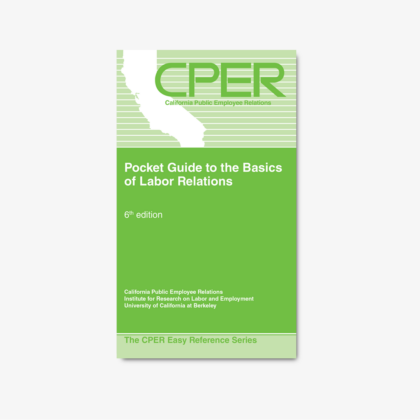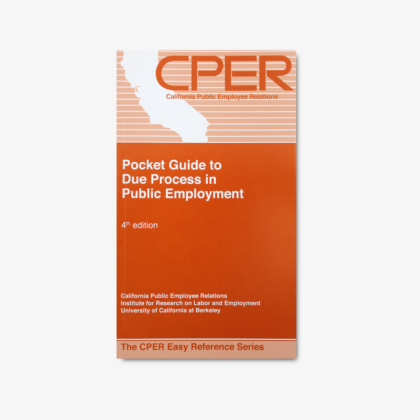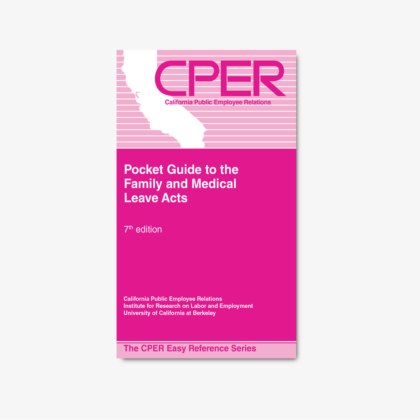In this rapidly evolving area of concern, California public employers must provide a drug-free workplace while avoiding overbroad policies that discriminate against individuals with disabilities and unduly invade privacy.
This topic is increasingly relevant in light of the recent legislation of marijuana in California.
The CPER guide provides best practices for employers while safeguarding employees’ privacy rights and legitimate medical needs.
The authors address common issues and pitfalls in workplace drug and alcohol policies as well as application of relevant laws and statutes.
Chapters cover prescription drugs in the workplace; medical and recreational marijuana; how to create effective policies; drug and alcohol testing; granting leave; employee assistance programs; state and federal laws and statutes; and more.
As always, the CPER format is readable and convenient to reference, with relevant laws and statutes, case law, glossary, table of cases, and index.
Table of Contents
- Introduction (Page 1)
- Drug Use in the Workplace (Page 8)
- Relevant Laws/Statutes (Page 10)
- FEHA (Gov. Code sections 12900-12996) (Page 10)
- ADA (42 U.S.C. sections 1210, et seq.) (Page 11)
- Duty to engage in the interactive process, provide reasonable accommodations to affected employees and avoid discrimination against individuals with disabilities (Page 11)
- Enforcement efforts by the Equal Opportunity Employment Commission (EEOC) (Page 19)
- Best Practices on Addressing Prescription Drug Use in the Workplace (Page 19)
- Proper action where an employee is suspected of being under the influence of illegal drugs or alcohol at work (Page 19)
- Documentation (Page 19)
- Disability-related inquiries, medical exams, and drug and alcohol testing (Page 22)
- Employers should establish a clear policy indicating when drug or alcohol testing will be required (Page 28)
- Employers should freely grant leave for employees to attend rehabilitation programs (Page 29)
- Employers should make clear that medical marijuana use at work violates their drug-free workplace policies (Page 31)
- Employers should be aware of different drug and alcohol testing requirements that apply to transportation employers or other “safety-sensitive” work environments (Page 32)
- Employee Assistance Programs (EAPs) (Page 33)
- Proper action where an employee is suspected of being under the influence of illegal drugs or alcohol at work (Page 19)
- Impact of California Marijuana Statutes on Employer Drug Policies (Page 34)
- Medical Marijuana (Page 34)
- Recreational Marijuana (Page 37)
- Legislative efforts related to reasonable accommodation (Page 38)
- Practical impacts of California’s marijuana laws in the employment context (Page 39)
- Imprecise testing (Page 39)
- Consistency in application of drug-free workplace policies (Page 39)
- Potential for disability discrimination claims (Page 40)
- Impacts of public agency policies related to marijuana sales and revenues (Page 40)
- Alcohol Use in the Workplace (Page 41)
- Relevant Laws/Statutes (Page 10)
- Drug and Alcohol Testing (Page 43)
- Drug and Alcohol Testing Rules for Employees Subject to Federal Department of Transportation Regulations (Page 44)
- Pre-hire testing (Page 48)
- Testing of current employees (Page 49)
- Post-accident testing (Page 49)
- Random testing (Page 50)
- Reasonable suspicion testing (Page 51)
- Return-to-duty testing (Page 52)
- Drug and Alcohol Testing Rules for Employees Not Subject to Federal Department of Transportation Regulations (Page 54)
- Pre-hire testing (Page 54)
- Testing for drugs (Page 54)
- Testing for alcohol (Page 56)
- Testing of current employees (Page 57)
- Post-accident testing (Page 57)
- Random testing (Page 58)
- Reasonable suspicion testing (Page 58)
- Return-to-duty testing (Page 59)
- Pre-hire testing (Page 54)
- Responses to Positive Tests for Illegal Drugs and/or Alcohol (Page 60)
- Applicants (Page 61)
- Current Employees (Page 63)
- Rehabilitation (Page 63)
- Employee Assistance Programs (Page 64)
- Last Chance Agreement (Page 65)
- Termination/Discipline (Page 67)
- Drug and Alcohol Testing Rules for Employees Subject to Federal Department of Transportation Regulations (Page 44)
- Case Law (Page 75)
- Government Drug Testing of Its Employees (Page 75)
- Common Law Tort Claims (Page 76)
- Pre-Employment Testing (Page 77)
- Testing of Current Employees (Page 77)
- Random Drug and Alcohol Testing Involving Employees That Serve in Safety Sensitive Positions (Page 78)
- Suspicionless/Random Testing (Page 79)
- California Alcohol and Drug Rehabilitation Act (Applicable to Private Sector Employers Only) (Page 79)
- Americans with Disabilities Act (ADA) (Page 80)
- Fair Employment and Housing Act (FEHA) (Page 81)
- Drug Testing and the National Labor Relations Board (NLRB) (Page 81)
- Statutes (Page 82)
- Federal Laws and Statutes (Page 82)
- United States Constitution, Amendment IV (Page 82)
- Drug-Free Workplace Act of 1988 (41 U.S.C. sections 8101-8106) (Page 82)
- Omnibus Transportation Employee Testing Act (49 U.S.C. sections 31301 and 31306) (Page 89)
- Department of Transportation Procedures for Transportation Workplace Drug and Alcohol Testing Programs (49 C.F.R. Part 40.1-40.413) (Page 96)
- Americans with Disabilities Act (42 U.S.C. sections 12101-12213) (Page 102)
- National Labor Relations Act (29 U.S.C. sections 141-187) (Page 114)
- California Laws and Statutes (Page 123)
- California Constitution (Page 123)
- California Alcohol and Drug Rehabilitation Act (California Labor Code sections 1025-1028) (Page 124)
- California Drug-Free Workplace Act of 1990 (Gov. Code sections 8350-8357) (Page 125)
- Compassionate Use Act (Health and Safety Code section 11362.5) (Page 127)
- Adult Use of Marijuana Act (Health and Safety Code sections 11362.1 and 11362.45(f)) (Page 128)
- Fair Employment and Housing Act (California Gov. Code sections 12900-12996) (Page 129)
- Federal Laws and Statutes (Page 82)
- Glossary (Page 146)
- Table of Cases (Page 151)
- Index (Page 154)




